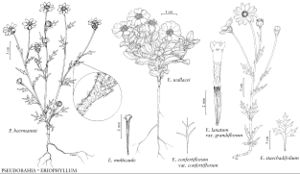Pseudobahia
in N. L. Britton et al., N. Amer. Fl. 34: 83. 1915.
Annuals, to 30 (–70) cm. Stems erect, usually branched. Leaves cauline; mostly alternate; usually petiolate; blades usually 1–2-pinnately lobed, sometimes 3-lobed or entire, faces sparsely to moderately woolly. Heads radiate, borne singly. Involucres hemispheric, 5–9 mm diam. Phyllaries persistent, (3–) 8 in 1 series (± erect in fruit, connate at bases or to 1/2 their lengths, elliptic, lanceolate, or oblanceolate, equal, margins somewhat hyaline, apices acute to acuminate, abaxial faces usually woolly). Receptacles conic to hemispheric, pitted or smooth, glabrous, epaleate. Ray-florets (3–) 8, pistillate, fertile; corollas yellow (with rings of hairs at bases of laminae). Disc-florets 8–25+, bisexual, fertile; corollas yellow (with rings of hairs at bases of limbs), tubes shorter than funnelform or cylindric throats, lobes 5, ± deltate (anther appendages deltate, widest at bases, glandular; style-branch appendages deltate). Cypselae ± obcompressed, 3–4-angled and obpyramidal to clavate, hairy or glabrate; pappi 0, or coroniform (minute scales). x = 4.
Discussion
Species 3 (3 in the flora).
B. G. Baldwin and B. L. Wessa (2000) found that Pseudobahia bahiifolia and P. peirsonii nest within a clade of Eriophyllum and Syntrichopappus species; circumscriptions of these genera are likely to change.
Selected References
None.
Key
| 1 | Leaves entire or 3-lobed | Pseudobahia bahiifolia |
| 1 | Leaves mostly 1–2-pinnately lobed | > 2 |
| 2 | Leaves mostly 1-pinnately lobed; phyllaries connate to 1/2 their lengths | Pseudobahia heermannii |
| 2 | Leaves mostly 2-pinnately lobed (except in smaller plants); phyllaries connate at bases | Pseudobahia peirsonii |
